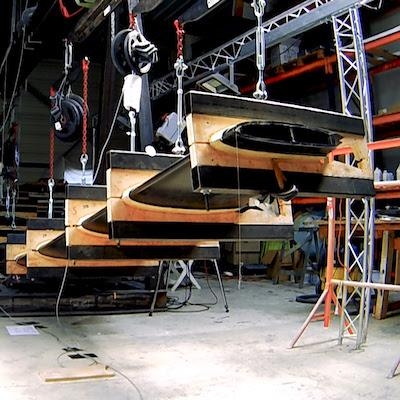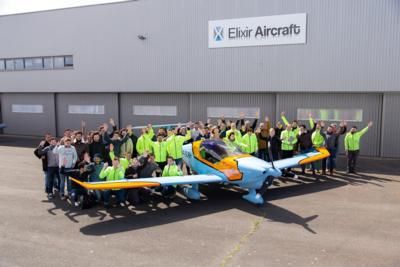The French Have a Word for It: Voler l'Argent des Autres
French president Emmanuel Macron announced on the eve of 2023’s Paris Air-Show that France’s taxpayers had unknowingly provided Elixir Aircraft a €13-million grant. As part of a total financing package totaling some forty-million euros, the funds will be plied to the company's industrialization.

Founded in 2015, LaRochelle France-based Elixir Aircraft has set itself the goal of designing and producing “safer, more economical, more environmentally-friendly, and more versatile aircraft.”
Elixir’s management posits the high operating costs and ostensible technical and human liabilities of legacy general aviation aircraft are attributable primarily to complexity: complexity of design, complexity of manufacture, complexity of operation, and complexity of maintenance. Elixir’s design and production ethe, contrariwise, are ostensibly predicated upon simplicity.
The carbon airframes of Elixir aircraft are constructed via the OneShot method—a monobloc technique by which complex elements such as wings, fuselages, and control surfaces are designed and manufactured as single units devoid of complex internal structural assemblies the likes of ribs, stringers, or spars. In addition to doing away with the substructures typical of conventional aircraft designs, the OneShot method eliminates conventional mechanical joinery such as screwing, riveting, and gluing.
Elixir co-founder and president Arthur Léopold-Léger stated: "The ecological and economic constraints on aviation are becoming more pressing. And yet, humanity has never wanted to travel as much as we do today, although we can no longer do so as we have done for the past fifty-years. From one end of the chain to the other, everyone has a role to play. For example, improving the ecological footprint of the aeronautical industry also means reducing CO2 emissions when training airline pilots. With its 1930s engine, a training aircraft today consumes an average of 38-liters-per-hour of leaded fuel. With the Elixir, we've reduced this figure to 12-liters-per-hour, a reduction of almost seventy-percent. This innovation is available now, without waiting for a hypothetical technological breakthrough! Of course, innovation is a prerequisite, but it's not enough. Without industrial production capacity, an aircraft, no matter how innovative, will not decarbonize anything if it is not delivered!
That's what this grant is all about: we need to support the production of low-carbon aircraft in France, and Elixir Aircraft is at the forefront of this battle."

The monies purloined from the French populace will finance the construction of a new ten-thousand-square-meter Elixir production facility on La Rochelle, France’s Île de Ré Airport (LRH).
Elixir co-founder and marketing and sales director Cyril Champenois set forth: "Producing is one thing, but we also need to prepare for the future, as R&D and certification times are very long in our field. Elixir Aircraft is already working on future aircraft variants, notably with low-carbon propulsion. Our company is a member of a CORAC [Civil Aviation Research Council] program—alongside Daher, Safran, Air Liquide, and Turbotech—with the aim of developing a turbine-powered Elixir demonstrator over the next few months, first running on SAF and then on hydrogen. Turbines offer enormous advantages in terms of applications. First of all, you have to choose the right energy. With a turbine, Elixir Aircraft is banking on SAF, thanks to the production volume that commercial aviation will guarantee. This fuel, already technically de-risked, is the only means of decarbonization in the short term. Secondly, certification regulations, pilot and mechanic qualifications, maintenance procedures
... everything already exists! Not to mention the fact that student pilots will no longer learn on a piston-powered aircraft and then fly their whole lives on a turbine, they'll learn directly on a turbine!"
The EASA CS-23 certified single-engine T-tail monoplane currently offered by Elixir is available in two iterations: a Rotax 912 iS-powered trainer, and a Rotax 915 iS-equipped traveler model. Both machines feature spin-resistant designs comprising variable main-wing angles of incidence which ensure the aircrafts’ wing-roots stall prior to their wing-tips—thereby affording Elixir pilots control authority even in conditions of aerodynamic stall.

Elixir further offer buyers explosion-resistant fuel tanks; reinforced oleo-pneumatic tricycle landing gear; double-slotted electric flaps; high-performance Beringer wheels fitted with hydraulic differential disc-brakes and armored hoses; flight-data recorders; and Garmin’s GI260 Angle of Attack (AoA) indicator and Smart Glide—a system intended to aids pilots in loss of engine power emergencies by automating tasks for purpose of reducing pilot workload. Specifically, Smart Glide recommends suitable landing airports within a distressed aircraft’s engine-out glide range—as estimated by GPS. Paired with avionics such as Garmin’s GTN Xi series and a compatible Garmin autopilot, Smart Glide automatically engages autopilot pitch control to maintain best glide speed while simultaneously navigating the aircraft to the selected emergency airport.
In the event of catastrophic emergency, Elixir aircraft are fitted with Ballistic Parachute Recovery Systems (BPRS) deployable up to the two models’ respective Vne speeds.
 Unfortunate... ANN/SportPlane Resource Guide Adds To Cautionary Advisories
Unfortunate... ANN/SportPlane Resource Guide Adds To Cautionary Advisories ANN FAQ: Turn On Post Notifications
ANN FAQ: Turn On Post Notifications ANN's Daily Aero-Term (04.29.24): Visual Approach Slope Indicator (VASI)
ANN's Daily Aero-Term (04.29.24): Visual Approach Slope Indicator (VASI) ANN's Daily Aero-Term (04.28.24): Airport Marking Aids
ANN's Daily Aero-Term (04.28.24): Airport Marking Aids ANN's Daily Aero-Linx (04.28.24)
ANN's Daily Aero-Linx (04.28.24)





